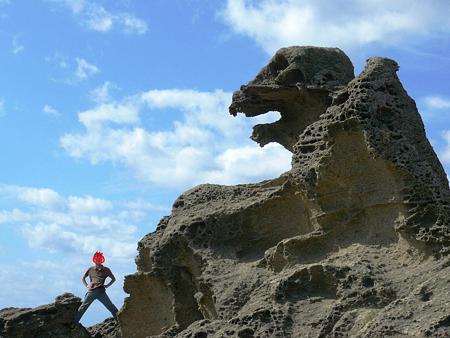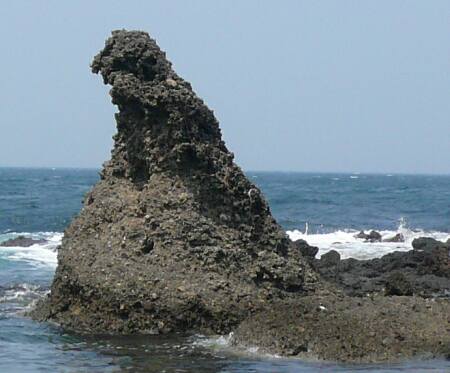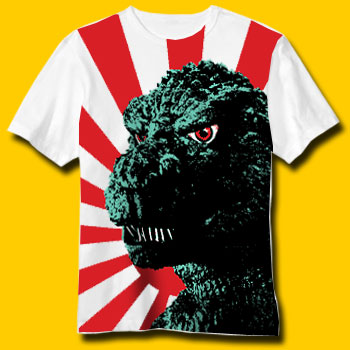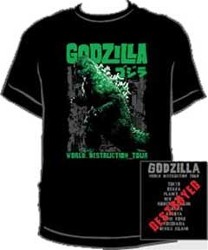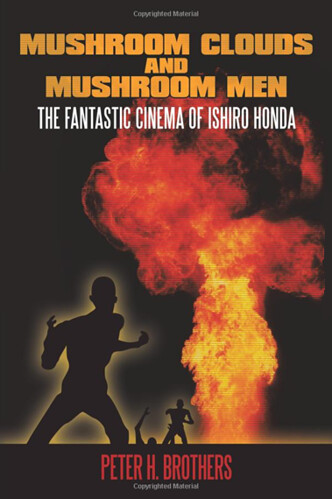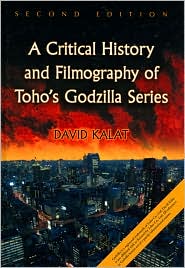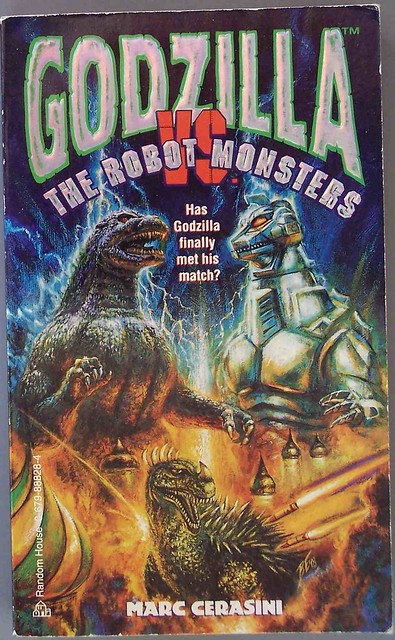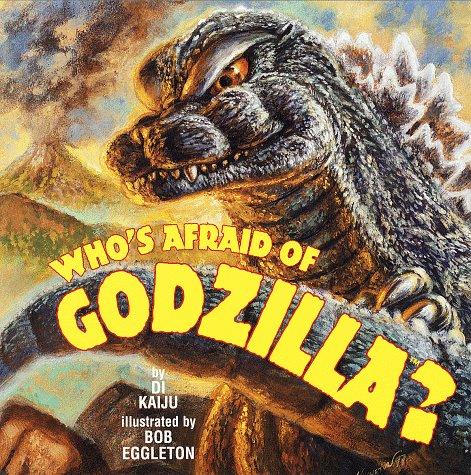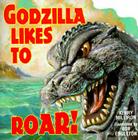But what most people don't know is that there have been many other entertaining kaiju eiga(giant monster movies) to come rom Japan that feature neither of these mon-stars. Most of these films were made in the 60's and 70's in an age before computer graphics. The special effects however, are good and there is something very satisfying and tactile about a real actor in a suit that CGI can't match. In fact, two of Godzilla's more famous monster co-stars got their start in their own movies. The stories of these films are often much more complex and interesting than those of more "realistic" American Sci-fi films. This is a top 10 list of these entertaining and lesser known kaiju films.
10. X From Outer Space (1968)
Monsters: Guilala, a.k.a. Gilala, a.k.a Girara
This was the first kaiju movie by studio Shochiku. In the future, the spaceship Gamma is sent from Japan to Mars to investigate U.F.O.s The Gamma encounters a U.F.O. which coats the ship in strange spores. The spores are returned to Earth, where they grow and develop into the giant lizard/chicken-like monster Guilala. The beast shoots fireballs from it's mouth and turns into an energy orb to fly. It sets out to destroy Japan and all attempts by the military fail. It is finally stopped by coating the creature with Guilalalium, a substance which causes it to shrink back to spore size. The spore is then shot back into space.
The movie tries to take itself seriously, but it's kind of hard because of the rather comical appearance of the monster with bulgy limbs and odd, spotted skin. Still, the special effects are pretty good. Guilala had a second movie, The Monster X Strikes Back/Attack the G8 Summit(2008). This film however, was a pure comedy and political satire featuring many actors impersonating famous political figures like Bill Clinton and former Japanese Prime Minister Junichiro Koizumi. In this film, Guilala fights another giant, Take-Majin, a Golden idol God played by gangster action star and comedian "Beat" Takeshi Kitano. Gilala was also the subject of a light-hearted T.V. commercial by career consultants, The Ladders.
9. Frankenstein Conquers The World (1966)
Monsters: "Frankenstein", Baragon
During WWII, the Japanese obtain the immortal heart of the Frankenstein Monster in a sealed case, from Europe. The heart is taken to Hiroshima for experimentation just before the dropping of the atomic bomb. The heart vanishes in the blast. Many years later there is a wild Caucasian boy spotted killing and feeding on animals. The boy is eventually captured and soon is believed to be the reincarnation of the Frankenstein Monster. The boy has a strong resistance to radiation and is also growing in size at an alarming rate. Frankenstein is also befriended by the beautiful Sueko, who sympathizes with the child-like creature. Frankenstein grows to a giant and escapes. There are many disasters and deaths which are wrongly blamed on Frankenstein. These are actually caused by a new monster, the subterranean and man-eating Baragon. Frankenstein is sought out by Sueko and others, but instead are found by Baragon. The monster advances with the intention of eating Sueko, but she is saved by Frankenstein who suddenly appears and battles the monster. In the end there is a titanic earthquake that splits the earth, swallowing the two monsters.
This s surely one of Toho's most bizarre films with a European monster who appears with no suit at all and little make up. The battle scenes are fast paced, with the two monsters grappleing like wrestlers. but the lack of suit for Frankenstein kind of breaks the suspention of disbelief. Baragon later had a very brief cameo in the famous Destroy all Monsters(1968) along with Godzilla and a whole monster cast. Baragon was scheduled to destroy Paris in that movie, but was replaced with Gorosaurus. The Baragon suit was also used several times on the T.V. show Ultraman. Baragon was later resurrected in the movie Godzilla, Mothra and King Ghidorah: Giant Monsters All-Out Attack (2001). In that film, Baragon was good, a protector of Japan, but was killed by a very evil Godzilla in one of the best fight scenes ever made.
8. Orochi: The Eight-Headed Dragon(1994)
Monsters: Kumasogami, Kaishin Muba, Orochi, Utsuno Ikusagami.
This movie was made by the same team that did the Heisei Godzilla films of the 90's. A period fantasy based on Japanese mythology. After Prince Yamato kills his brother, the Emperor exiles him. Yamato possesses a strange and deadly "power", which he can't fully control. Later he meets the priestess Oto who is supposed to be sacrificed to the Lava-demon god, Kumasogami. Yamato and his comrades come to her rescue. Kumasogami can morph its limbs into weapons, but Yamato defeats him with green energy beams from his eyes. Yamato and Oto later encounter the sea serpent Kaishin Muba, but Yamato's destiny is to rid the world of the eight-headed dragon, Orochi which is the reincarnation of an evil god. In the climactic battle scene, Yamato is transformed into the giant mecha warrior, Utsuno Ikusagami.
This is an exciting movie with great special effects and monsters. It is the retelling of a famous Japanese myth similar to the story of Hercules and the Hydra. In the original story, Susanoo, (Susanoo-no-Mikoto), the hot-headed god and brother to the godess Amaterasu, is cast out of heaven. On Earth, he meets an old couple whose daughter is to be sacrificed to the eight-headed dragon, Orochi. Susanoo falls in love with the girl and sets out to slay the monster He succeeds by getting the eight heads drunk and then cuts them off. He finds a magical sword in the tail of the monster. That sword, along with a magic mirror and embryo shaped magatama jewel are the magical regalia of the Japanese Imperial family. Susanoo and his love exchange hair combs as a symbol of their love. This story is close to my heart because it comes from the area of Japan where I live. Susanoo is enshrined at Kumano Taisha in Shimane Prefecture and is said to be the spot where Susanoo fell to Earth. Kumano Taisha is closely associated with the more famous Izumo Taisha nearby. Kumano is a shrine for finding a spouse and I have an American friend who was married there. They also have a large mural of the story of Susanoo. My wife and I have hair combs we bought there.
7. Rebirth Of Mothra Triligy (1996, 1997, 1998)
After appearing in Godzilla vs. Mothra(1992), Toho decided to give mothra her own series of movies. For number 7, I've included all three. These films were squarely targeted at children. Mothra's benevolent twin fairies are back, we now know as Moll and Lora, along with a new character, their evil sister fairy Belvera. The twin fairies spend most of their time riding around on Fairy Mothra and Belvera on a small dragon named Garu-garu. Each film has child protagonists who help the fairies along. The stories are not so serious and focus on adventure, nevertheless, the special effects are fantastic. Mothra appears in a dizzying array of forms throughout the trilogy, no doubt targeting the toy market and include: Mothra, Mothra Leo, Fairy Mothra, Rainbow Mothra, AquaMothra, Primitive Mothra, Armor Mothra, Light Speed Mothra, and Eternal Mothra. We also see a lot of King Ghidorah in various forms, a pairing that starts to get a little old. It's hard to believe Mothra could take out King Ghidorah by himself, but I have to admit, the Grand King Ghidorah in Mothra III is probably the most impressive Ghidorah ever put to film. Too bad Big-G wasn't there to take him on.
Rebirth of Mothra I
Monsters: Mothra, Mothra Leo, Death-Ghidorah
Long before Godzilla: Final Wars (2004), we see the first appearance of a four-legged Ghidorah monster. Millions of years ago, a huge monster, Death-Ghidorah arrives to destroy Earth. The invader is stopped, however by giant monster moths who are the guardians of a race of tiny people called Elias. Death-Ghidorah is imprisoned in the Earth under a magical seal. Only three Elias sisters survive, Moll, Lora, and Belvera. The first two stay with the last Mothra, but the last sister becomes twisted and vengeful at the extinction of her race. In modern day, Mothra lays an egg and is weakened. Also, a group of loggers unintentionally uncover Death-Ghidorah's prison and Belvera releases him. Mothra attacks, but is losing. Her egg hatches and Mothra Leo larvae emerges to help its mother. Death-Ghidorah mortally wounds the larvae and Mothra saves her child, but dies as a result. Mothra Leo spins a cocoon and transforms to adult form. Mothra Leo returns with a vengeance and defeats Death-Ghidora, imprisoning him once more.
Rebirth of Mothra II (Mothra 2: The Undersea Battle)
Monsters: Mothra Leo, Dagahra
The coast of Japan is ravaged by poisonous starfish-like creatures called Barem. With the help of some children and a strange creature "Gorgo", the fairies uncover the hidden temple of an ancient undersea kingdom called the Ninai Kanai that rises out of the sea. This civilization created a sea monster guardian called Dagahra, which has turned evil and is releasing the Barem. Mothra Leo attacks, but is severely wounded and covered in Barem. The children and fairies try to find the hidden treasure that will save Mothra an belvera and some brainwashed fisherman try to top them. It is discovered that Gorgo is the hidden treasure and they use his power to revive Mothra. He transforms into Rainbow Mothra to fight Dagahra and again into AquaMothra to take the battle underwater. AquaMothra defeats the monster. Everyone escapes as the temple sinks beneath the waves again. The world is saved.
Rebirth of Mothra III (Mothra 3: King Ghidorah Attacks)
Monsters: Mothra Leo, Cretaceous King Ghidorah, Grand King Ghidorah
A huge meteor lands on Earth containing Grand King Ghidorah who has visited Earth's ancient past and is believed to have caused the extinction of the dinosaurs. A boy, Shota plays hooky from school to investigate the meteor. Meanwhile, school children all over start dissapearing and are taken by Ghidorah to an organic dome near the meteor. Rainbow Mothra arrives to battle, but King Ghidorah is far too powerful and Mothra only just escapes. Later, Lora is turned evil by Ghidorah and attacks her sister Moll, trying to pull her into the dome. Fairy mothra saves Moll and Belvera is trapped inside. Moll teams up with Shota and tells him Ghidorah needs the energy of the children. As Ghidorah is far too powerful, it is decided that Mothra must travel to Earth's past to battle the older form of Ghidorah. Using Moll's energy, Mothra transforms to Light Speed Mothra. He travels to the past and battles Cretaceous King Ghidorah and defeats him, but not before a piece of it's tail falls off burying itself in the earth. Mothra is exhausted, however and encased in a suspended animation cocoon by the other prehistoric Mothra larvae. In the present, Ghidorah disappears, but is soon replaced by a new Ghidorah hat grew from the broken tail from the past. Mothra revives in the present and transforms to Armor Mothra who finally defeats Ghidorah. In the end, the three Fairy sisters are reconciled.
6. Varan The Unbelievable (1962)
A group of scientists journey to a remote saltwater lake to catch rare butterflies. The local villagers worship a monster diety Varan who lives in the lake and scientists are killed by the monster. The millitary arrives, but his only results in angering Varan. It destroys the village before spreading the membranes between its limbs like a flying squirrel and flies at supersonic speed to Tokyo. Varan seems unstoppable but is tricked ino eating bombs which explode inside. The monster returnes to the sea before the last bomb goes off.
This is a really solid Kaiju Eiga film with good special effects and music. It was made in black and white, which really adds to the dark atmosphere. I'm just guessing here, but I think the name Varan comes from the word varanoid, which is the scientific name of a class of large lizards which includes prehistoric mosasaurs and modern day Komodo dragons. Varan made a tiny cameo in Destroy All Monsters(1968), with only a glimpse on screen. There were several other planned projects and appearances that were later scrapped. Varan remains one of the most unknown and under appreciated kaiju from Japan. He really deserves a comeback.
5. King Kong Escapes (1967)
Monsters: King King, Robot Kong, Gorosaurus, giant snake monster
This movie is so much fun to watch and has great action. An evil genius, Dr. Who (not to be confused with the other doctor from England) has succeeded in creating a giant robot version of King Kong. The purpose, well..to dig up a special radioactive substance "Element X", which is somehow associated with his 007-like plot of world domination. What better way to mine a radioactive ore than by using a giant robot gorilla? The only problem is, the radioactivity makes Robo Kong short circuit. The solution? Kidnap the real Kong to work in the mine, of course! At the same time a submarine crew with some Americans have gone to Mondo island to look for the real Kong. Instead, they find Gorosaurus, a giant dinosaur that advances toward the female crew member Susan Watson. Kong suddenly appears and saves her, killing the dinosaur in almost exactly the same way King Kong did in the original 1933 film. He also saves the crew from a giant sea snake. Dr. Who succeeds in kidnapping Kong and the submarine crew. Dr. Who uses a special flashing light on top of Robo Kong's head to hypnotize Kong into working in the mine. Kong soon recovers and all escape back to Tokyo. Robo Kong pursues and catches Susan. Kong goes to the rescue and the battle rages as the two giants climb up Tokyo Tower. Who will win?
This was Kong's second film appearance after the immensly popular King Kong vs. Godzilla. The Kong suit was much improved over the first film. A little known fact was that the story was loosely based on an American, Rankin/Bass TV cartoon, The King Kong Show. It was the first appearance of Gorosaurus, who despite being killed, reappeared in Destroy All Monsters, destroying the Arc de Triumph in Paris, a role originally meant for Baragon. He also gave a famous kangaroo kick to King Ghidorah in the climactic battle scene. The confident and arrogant Dr. Who was wonderfully played by Eisei Amamoto, well known to Kaiju fans and instantly recognizable for his incredibly bad teeth. He had many small roles in Godzilla films including the kindly toymaker in All Monsters Attack and Princess Salno's short lived butler in Ghidorah, the Three Headed Monster right before the plane blows up. In 2001 he starred in Godzilla GMK, my all time favorite kaiju film, as a strange old man who prophesies the coming of the guardian monsters against a very evil Godzilla. It was his last film role before his death in 2003.
 4. War of The Gargantuas (1970)
4. War of The Gargantuas (1970)Monster: Gaira, Sanda
This film was a kind of sequel to Frankenstein vs. Baragon. The two giant monsters are said to have grown from Frankenstein's cells, though this is not clear in the film. They are described as brothers. The story is sublime and takes on almost mythic proportions. It is a giant version of Caine vs. Able, a battle of dualities. One monster is green and aggressive, a man-eater whose domain is the ocean. Its name is Gaira, derived from the Japanese word for "sea". The other monster is brown, peaceful and kindly towards humans. It lives on land and name is Sanda, derived from the word "mountain".
One day, a giant green humanoid monster Gaira appears in the sea. Part hairy, part scaly. it battles a giant octopus before destroying the ship it was attacking and eats most of the crew.Later, it invades an airport and eats more people. The Japanese military attacks it with electricity and nearly kill it, before its brother Sanda appears and helps. It comes to light that Sanda was found in its youth by some scientists and spent some time with humans before escaping to the mountains and growing to gigantic size. Later, Sanda discovers his brother's bloodlust for humans, and enraged, attacks him. The two giants battle until they are finally destroyed by a volcanic eruption.
There are subtle emotions that play out between the two monsters. Sanda is the most moralistic and emotionally expressive of any other kaiju, not just because he is friendly to humans, but he tries to help his brother, too. He just doesn't like a pretty girl like King Kong. We feel him torn between two worlds. Ironically, because Sanda is acted in a suit, these emotions play better on screen than in Frankenstein of the previous film. I can't help but think that these two monsters were in part inspired by the famous 17th century artwork of two gods, Raijin and Fujin, the deities of thunder and wind respectively. One imagines they are brothers and seem ready for battle. I see Gaira and Sanda reflected there.
3. Daimajin Trilogy (1966)
Monsters: Daimajin
Daimajin is the story of stone idol monster that can change its face and was made by Daiei Studios, the same studio responsible for Gamera. Daimajin stands apart from other Kaiju Films and is one of the few stories to take place in ancient Japan There were three movies, all made in 1966 and released months apart.
Daimajin
In ancient Japan there is an earthquake that the villagers believe is the spirit of Damajin, a spirit trapped in the mountain. They follow the priestess to the shrine to pray. The feudal lord is a good man, but his chamberlain Samanosuke has been waiting for a chance to take over. He takes the opportunity and murders the lord and his wife, but their young son Tadafumi and daughter Kozosa escape with the help of a loyal samurai, Kogenta. Later the three are aided by the pristess who takes them deep into the mountains to where the stone idol statue stands with a peaceful, Buddha-like face half buried in the mountainside. The place is secret and they start to live in a small temple need the statue. Years later, Tadafumi has become 18 years old. The people of the village have suffered under the tyranical rule of Samanosuke. Attempting to gather loyal supporters for a rebellion, Kogenta and Tadafumi are captured. Samanosuke kills the priestess and orders his men to go and destroy the stone idol. In the mountains, they discover Kozosa who is forced to take them to the statue. The samurai hammer a large wooden stake into the forehead of the idol and are horrified when blood seeps from the hole. Then there is an earthquake that swallows up all the samurai. Kozosa prays to Daimajin and offers her life if it saves Tadafumi and Kogenta. The rocks fall away and the statue steps forward. Daimajin raises its arm and the benevolent stone face changes to the green face of an angry deity. Tadafumi and Kogenta have been tied to crosses to await execution. Daimajin appears and starts destroying the castle. The samurai try to stop it, but the idol is too strong. It frees the heroes and kills Samanosuke, impaling him on the wooden stake from its forehead. Daimajin goes on a rampage, destroying everything indiscriminately. It is about to crush Kozosa, but is stopped by her tear landing on its foot. The statue's face becomes peaceful again and the spirit returns to the mountain. Now lifeless, the statue crumples apart.
Return of Daimajin
In the second film, Daimajin now stands on a small island in the middle of a lake. The lake is bordered by two countries which are happy and peaceful. There is another country nearby that is unhappy and ruled by an evil lord. People keep escaping this land and moving to the happier countries. The evil lord is jealous and sees an opportunity to invade take over the other lands. There is soon to be a festival. People are on the run from the evil ruler and keep going to the island with the statue. Eventually the evil ruler's men blow up the statue with gunpowder and the broken pieces fall into the lake. Near the end of the film, there is an earthquake ad the wrathful Daimajin rises from the lake to punish the evil lord and destroys everything in its path. At the end, Daimajin stands in the waters and his face changes back to the peaceful one. His body changes to liquid water and disappears into the lake.
Wrath of Daimajin
In the third and final film, Daimajin now stands on top of a mountain. Some men have been captured by an evil warlord and forced to work in a labor camp. The four young sons of the men decide to try and save their fathers. Along the way, they stop to pay respects to the statue as not to incur his wrath. Later, angered by the evil warlord and at the pleas of one of the boys, Daimajin awakens. It destroys the labor camp and kills the warlord. It's the first time that Daimajin unsheathes and uses the short sword he wears at his waist, using it to impale the villain in the same way as the first film. This movie is also different n that the protagonists are commoners, not noblemen.
Daimajin remains a very popular monster with kaiju fans and is a good example of the dichotomous nature of Japanese kaiju. They are both savior and destroyer. Daimajin is a fearful demon, but is pleaded with to save the people. This dual nature is so clearly expressed in Daimajin's two faces. As with the Gargantuas, Daimajin is performed in a suit, but the actors eyes are visible, allowing the expression to come through. His eyes flash with rage as he dispatches the villains and at times look compassionately on the helpless. Daimajin's armor and flayed skirt are not that of a samurai, but belong to a much older period of Japan's history.Daimajin never fights any other monsters, but in one issue of Godzilla comics by Dark Horse in the 1990's, Godzilla fights a Daimajin-like stone demon called Gekido-jin.
There was talk a few years back of a new Daimajin movie that never happened, but in 2010 there was a short lived TV show called Daimajin Kanon. This show was rather silly though and changed the story a lot. It took place in modern times and was more like Masked Rider or Ultraman with a band of superheros. Daimajin's look is much altered. He's got riped abs and pecks, but gone were his human eyes and two faces.
2. Rodan (1956)
Monsters: Meganuron, Rodan (male and female)
Rodan is known as Radon in Japan and the name is derived from the word pteranodon. Most likely, the name was changed in America as not to be confused with the radioactive element radon. Rodan was the first daikaiju eiga filled in color and after the first two Godzilla films.
A small mining town is gripped by terror as miners go missing and are then found mutilated. Two police officers are killed in a similar fashion. The true killer is a giant hideous insect that emerges from the mine and attacks a miner Shigeru and his fiance Kyo in her home. The creature kills some more policemen and escapes into the mine. The monster is identified as meganuron, a giant, prehistoric insect larvae. Shigeru and the police descend into the mine, discover the body of Kyo's brother and finally kill the monster, before an earthquake causes a landslide and traps Shigeru inside. He is later found wandering outsde the mine and suffering from amnesia. In one good scene, at the hospital Shigeru watches a small bird in a cage which triggers a horrible flashback. He recovers his memory and relates his story. He was trapped in a giant, underground cavern and sees many meganuron along with an enormous egg. The egg hatches and a gigantic bird-like monster emerges. Dwarfing the meganuron in size, the monster quickly starts eating them. A few days later, a giant U.F.O is sighted. It has a wingspan of 500 feet and flies at supersonic speeds. The military track down Rodan's lair in a dormant volcano. The attack to no avail and a second rodan is spotted. The first monster(presumably male) attacks and destroys Sasebo and returns to the volcano. The military attack again, hoping to trap the monsters inside. The attack causes a volcanic eruption and one rodan creature is caught in the lava with its mate flying round helplessly. In the end, instead of escaping, it dives into the lava, choosing to die together with its mate.
Rodan later appeared in Godzilla films such as Ghidorah the Three-Headed Monster and Destroy All Monsters. Rodan came back in a smaller version in the 1990's movie Godzilla vs. Mechagodzillaand had a close connection to Baby Godzilla. Rodan also destroyed New York in Godzilla: Final Wars. The original Rodan movie posed a question, If the giant meganuron insects were the larvae, what would the adult be? This question was answered in 2000's Godzilla vs. Megaguirus.In that film, a swarm of two meter dragonfly monsters attacks Godzilla before the giant "queen" Megaguirus monster appears.
1. Mothra (1961)
One of the best monster movies of all time, with colorful, almost cute monster hero. In this film the real villain is the scrupulous entrepreneur. Infant Island was the location of atomic tests by the fictitious nation of Rolisica. A ship runs aground there after a typhoon. The sailors are later rescued and amazingly are unaffected by radioactivity. They claim it was because of a special drink given to them by the native inhabitants. A Japanese-Rolician expedition led by the capitalist Clark Nelson goes to the island to investigate. There they encounter the natives and two tiny, twin "fairy" girls dubbed the "Shobijin". They find a hieroglyphic cross-star symbol that translates to "Mothra". They also find the enormous egg of Mothra, their god. The tiny girls plead with the visitors to protect their island from more atomic tests. They agree and keep the secret upon returning. Nelson, however, seeing an opportunity to get rich, later returns to the island to kidnap the girls, shooting any natives who get in the way. He opens a show in Tokyo with the two girls singing. Despite efforts from the reporter and scientist protagonists, Nelson refuses to let them go and the girls sing and summon Mothra telepathically to save them. The mothra larvae hatches from the egg and swims towards Tokyo, destroying a ship along the way. It attacks Tokyo and is imperious to the military attacks. Nelson takes the girls and escapes to his native country of Rolisica. Mothra spins a cocoon and emerges as a giant moth. Mothra pursues the girls to Rolisica. Nelson is finally killed in a shootout with police, but Mothra continues her rampage. The heroes see the shadow of a cross from a church steeple and are reminded of Mothra's star symbol. They organize to paint a giant version of the symbol on the airport runway. Mothra lands, retreives the girls and peacefully flies back to Infant Island.
The fairies were played by a pair of singers known as the "Peanuts" who later appeared in Godzilla vs. Mothra and Ghidorah the Three-Headed Monster. They were not twins or related. The fictitious country of Rolisica is a metaphor for America and Russia and the vilian Nelson represents the unhindered capitalism that came in the post war economic boom in Japan. There was also alution to Christianity and Mothra's symbol, which was used again in future Mothra films, closely resembles the Celtic cross. Mothra is the most popular and recognizable Kaiju after Godzilla and has appeared in over a dozen films.













